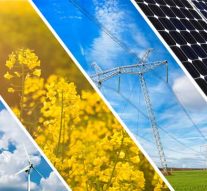
The year of renewable energy
Energy 10 January 2021The year 2020 was full of positive surprises for the environment, because of the Covid-19 crisis with the multiple states lockdown, the new year begins with a surging growth for renewable energy.
Growth will likely continue into 2021, fueled in part by last year’s major turning points. China has now committed to reaching carbon neutrality by 2060, putting the world’s biggest market for solar and wind power on the path to ramp up installations as it begins its next five-year plan. Even after the government locked down large swathes of the country early in the year, businesses still wanted solar. The country’s main solar industry group expects a record surge in business over the next five years following President Xi Jinping’s September engagement in the zero carbon industry. An explosion and a flood shut down two Chinese factories that produce polysilicon, a crucial material for photovoltaic cells, sending prices up 75% in less than two months. Solar glass prices also soared as increased use of two-sided, or bifacial, panels boosted demand, while capacity was constrained by limits on heavily polluting glass factories in China. Rising costs have so far not affected sales, but they have rippled through the solar supply chain, with module prices experiencing the first quarterly rise since 2015. That could be bad news for project developers who bid low prices assuming equipment costs would continue to follow their long historic decline.
Some analysts have started predicting that the U.S. power sector is approaching peak natural gas. That would leave room for solar-panel installations to build on the ongoing boom. Residential installations in the U.S. dropped nearly 20% in the second quarter of 2020 from the first—the most ever—as the pandemic prompted stay-at-home orders, according to Wood Mackenzie and the Solar Energy Industries Association. By the end of the year, however, the sector bounced back and the country added 19 gigawatts of total solar power, based on projections in December from Wood Mackenzie and SEIA. That would be slightly more power than existed in the entire nation of Colombia at the end of 2019.New battery-storage capacity in the U.S. more than doubled in the third quarter of 2020 from the second, according to Wood Mackenzie and the U.S. Energy Storage Association. Projects in California were a key reason for the surge.
During the height of the pandemic, when overall power demand sank, renewable power’s share of the grid surged in Europe. About 40% of the electricity in the first half of 2020 in the European Union came from renewable sources, compared with 34% from plants burning fossil fuels, according to environmental group Ember. Electricity from solar farms in Spain with Europe’s greatest solar potential was up over 60% in 2020 compared to 2019, generating over 15,000 gigawatt hours of power, according to data from the country’s grid manager Red Electrica. While the sunny Southern European country still has about a third of the installed solar capacity as the EU’s leader Germany, Spain’s sector is set to grow at about double the Germans’ pace in the next two years, according to BloombergNEF.
A 67-day period became Britain’s longest stretch without coal since the Industrial Revolution and helped make 2020 the country’s greenest year yet for its power grid. Britain is going to completely phase out the polluting fuel by 2025 as a growing share of its power comes from wind farms. Prime Minister Boris Johnson also vowed to ban new gas-power cars by 2030 and spend $1 billion this decade to capture carbon emissions from at least two industrial hubs.
India’s debt-burdened utilities were further battered by the world’s largest lockdown in 2020, leading to a 72% drop in solar installations and the slowest addition of wind power in more than a decade. On the plus side, though, bids to develop new solar projects continued to set new records—meaning that once power company finances are in order, it’s a good bet that solar will be the cheapest option. Another bit of good news was that clearer skies when factories and streets were empty meant that there wasn’t as much smog blocking the sunshine, allowing for higher generation from the country’s existing panels.
The IEA forecasts that additions of renewable electricity capacity will decline by 13% in 2020 compared with 2019, the first downward trend since 2000. This is a 20% downward revision compared to our previous forecast in which 2020 was due to be a record year for renewable power. The update reflects both possible delays in construction activity due to supply chain disruptions, lockdown measures and social‑distancing guidelines, and emerging financing challenges. The outlook also takes into account ongoing policy uncertainty and market developments such as the most recent auctions and newly financed projects before the Covid-19 outbreak.
However, the majority of these delayed projects are expected to come online in 2021 and lead to a rebound in capacity additions. As a result, 2021 is forecast to almost reach the level of renewable capacity additions of 2019. Despite the rebound, the combined growth in 2020 and 2021 is almost 10% lower compared to the previous IEA forecast.
Covid-19 has just given a positive side effect to the energy world, which will continue its path (even without further lockdown, hopefully) towards sustainable sources in the next decades.





